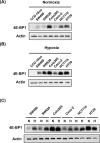eIF4E binding protein 1 expression is associated with clinical survival outcomes in colorectal cancer
- PMID: 26204490
- PMCID: PMC4695172
- DOI: 10.18632/oncotarget.4483
eIF4E binding protein 1 expression is associated with clinical survival outcomes in colorectal cancer
Abstract
eIF4E binding protein 1 (4E-BP1), is critical for cap-dependent and cap-independent translation. This study is the first to demonstrate that 4E-BP1 expression correlates with colorectal cancer (CRC) progression. Compared to its expression in normal colon epithelial cells, 4E-BP1 was upregulated in CRC cell lines and was detected in patient tumor tissues. Furthermore, high 4E-BP1 expression was statistically associated with poor prognosis. Hypoxia has been considered as an obstacle for cancer therapeutics. Our previous data showed that YXM110, a cryptopleurine derivative, exhibited anticancer activity via 4E-BP1 depletion. Here, we investigated whether YXM110 could inhibit protein synthesis under hypoxia. 4E-BP1 expression was notably decreased by YXM110 under hypoxic conditions, implying that cap-independent translation could be suppressed by YXM110. Moreover, YXM110 repressed hypoxia-inducible factor 1α (HIF-1α) expression, which resulted in decreased downstream vascular endothelial growth factor (VEGF) expression. These observations highlight 4E-BP1 as a useful biomarker and therapeutic target, indicating that YXM110 could be a potent CRC therapeutic drug.
Keywords: YXM110; colorectal cancer (CRC); eIF4E binding protein 1; hypoxia; prognosis.
Conflict of interest statement
The authors declare that have no conflict of interest.
Figures






Similar articles
-
Depletion of 4E-BP1 and regulation of autophagy lead to YXM110-induced anticancer effects.Carcinogenesis. 2013 Sep;34(9):2050-60. doi: 10.1093/carcin/bgt146. Epub 2013 Apr 30. Carcinogenesis. 2013. PMID: 23633518
-
Perillyl alcohol efficiently scavenges activity of cellular ROS and inhibits the translational expression of hypoxia-inducible factor-1α via mTOR/4E-BP1 signaling pathways.Int Immunopharmacol. 2016 Oct;39:1-9. doi: 10.1016/j.intimp.2016.06.034. Epub 2016 Jul 6. Int Immunopharmacol. 2016. PMID: 27394002
-
Imperatorin suppresses proliferation and angiogenesis of human colon cancer cell by targeting HIF-1α via the mTOR/p70S6K/4E-BP1 and MAPK pathways.J Ethnopharmacol. 2017 May 5;203:27-38. doi: 10.1016/j.jep.2017.03.033. Epub 2017 Mar 21. J Ethnopharmacol. 2017. PMID: 28341244
-
The eIF4E2-Directed Hypoxic Cap-Dependent Translation Machinery Reveals Novel Therapeutic Potential for Cancer Treatment.Oxid Med Cell Longev. 2017;2017:6098107. doi: 10.1155/2017/6098107. Epub 2017 Nov 26. Oxid Med Cell Longev. 2017. PMID: 29317983 Free PMC article. Review.
-
Targeting Translation of mRNA as a Therapeutic Strategy in Cancer.Curr Hematol Malig Rep. 2019 Aug;14(4):219-227. doi: 10.1007/s11899-019-00530-y. Curr Hematol Malig Rep. 2019. PMID: 31231778 Review.
Cited by
-
Protein Arginine Methyltransferase 5 as a Therapeutic Target for KRAS Mutated Colorectal Cancer.Cancers (Basel). 2020 Jul 28;12(8):2091. doi: 10.3390/cancers12082091. Cancers (Basel). 2020. PMID: 32731506 Free PMC article.
-
Targeted therapy of cancer stem cells: inhibition of mTOR in pre-clinical and clinical research.Cell Death Dis. 2024 Sep 30;15(9):696. doi: 10.1038/s41419-024-07077-8. Cell Death Dis. 2024. PMID: 39349424 Free PMC article. Review.
-
Eukaryotic translation initiation factor 4E binding protein 1 (EIF4EBP1) expression in glioblastoma is driven by ETS1- and MYBL2-dependent transcriptional activation.Cell Death Discov. 2022 Feb 28;8(1):91. doi: 10.1038/s41420-022-00883-z. Cell Death Discov. 2022. PMID: 35228525 Free PMC article.
-
Mechanisms of miR-3189-3p-mediated inhibition of c-MYC translation in triple negative breast cancer.Cancer Cell Int. 2022 May 31;22(1):204. doi: 10.1186/s12935-022-02620-z. Cancer Cell Int. 2022. PMID: 35642054 Free PMC article.
-
Advancing Colorectal Cancer Diagnostics from Barium Enema to AI-Assisted Colonoscopy.Diagnostics (Basel). 2025 Apr 11;15(8):974. doi: 10.3390/diagnostics15080974. Diagnostics (Basel). 2025. PMID: 40310348 Free PMC article. Review.
References
-
- Smith RET, Renaud RC, Hoffman E. Colorectal cancer market. Nat Rev Drug Discov. 2004;3:471–472. - PubMed
-
- Walther A, Johnstone E, Swanton C, Midgley R, Tomlinson I, Kerr D. Genetic prognostic and predictive markers in colorectal cancer. Nat Rev Cancer. 2009;9:489–499. - PubMed
-
- Ribic CM, Sargent DJ, Moore MJ, Thibodeau SN, French AJ, Goldberg RM, Hamilton SR, Laurent-Puig P, Gryfe R, Shepherd LE, Tu D, Redston M, Gallinger S. Tumor microsatellite-instability status as a predictor of benefit from fluorouracil-based adjuvant chemotherapy for colon cancer. The New England journal of medicine. 2003;349:247–257. - PMC - PubMed
-
- Gangadhar T, Schilsky RL. Molecular markers to individualize adjuvant therapy for colon cancer. Nat Rev Clin Oncol. 2010;7:318–325. - PubMed
Publication types
MeSH terms
Substances
LinkOut - more resources
Full Text Sources
Other Literature Sources
Medical
Research Materials
Miscellaneous

